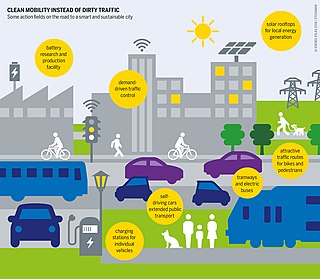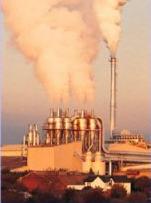Related Research Articles

Emissions trading is a market-based approach to controlling pollution by providing economic incentives for reducing the emissions of pollutants. The concept is also known as cap and trade (CAT) or emissions trading scheme (ETS). One prominent example is carbon emission trading for CO2 and other greenhouse gases which is a tool for climate change mitigation. Other schemes include sulfur dioxide and other pollutants.

Environmental engineering is a professional engineering discipline related to environmental science. It encompasses broad scientific topics like chemistry, biology, ecology, geology, hydraulics, hydrology, microbiology, and mathematics to create solutions that will protect and also improve the health of living organisms and improve the quality of the environment. Environmental engineering is a sub-discipline of civil engineering and chemical engineering. While on the part of civil engineering, the Environmental Engineering is focused mainly on Sanitary Engineering.

Environmental science is an interdisciplinary academic field that integrates physics, biology, and geography to the study of the environment, and the solution of environmental problems. Environmental science emerged from the fields of natural history and medicine during the Enlightenment. Today it provides an integrated, quantitative, and interdisciplinary approach to the study of environmental systems.
The California Air Resources Board is an agency of the government of California that aims to reduce air pollution. Established in 1967 when then-governor Ronald Reagan signed the Mulford-Carrell Act, combining the Bureau of Air Sanitation and the Motor Vehicle Pollution Control Board, CARB is a department within the cabinet-level California Environmental Protection Agency.

Sustainable transport refers to ways of transportation that are sustainable in terms of their social and environmental impacts. Components for evaluating sustainability include the particular vehicles used for road, water or air transport; the source of energy; and the infrastructure used to accommodate the transport. Transport operations and logistics as well as transit-oriented development are also involved in evaluation. Transportation sustainability is largely being measured by transportation system effectiveness and efficiency as well as the environmental and climate impacts of the system. Transport systems have significant impacts on the environment, accounting for between 20% and 25% of world energy consumption and carbon dioxide emissions. The majority of the emissions, almost 97%, came from direct burning of fossil fuels. In 2019, about 95% of the fuel came from fossil sources. The main source of greenhouse gas emissions in the European Union is transportation. In 2019 it contributes to about 31% of global emissions and 24% of emissions in the EU. In addition, up to the COVID-19 pandemic, emissions have only increased in this one sector. Greenhouse gas emissions from transport are increasing at a faster rate than any other energy using sector. Road transport is also a major contributor to local air pollution and smog.
Dr. Sarah Mary Liao Sau-tung, GBS, MBE, JP, FRSC was former Secretary for the Environment, Transport and Works of the Hong Kong Special Administrative Region and a member of the Executive Council of Hong Kong since 2002. She was appointed on 1 August 2002 and served until 2007. She is also a Senior Adviser to the Vice-Chancellor of the University of Hong Kong on Environmental and Sustainability Matters.

The Air Resources Laboratory (ARL) is an air quality and climate laboratory in the Office of Oceanic and Atmospheric Research (OAR) which is an operating unit within the National Oceanic and Atmospheric Administration (NOAA) in the United States. It is one of seven NOAA Research Laboratories (RLs). In October 2005, the Surface Radiation Research Branch of the ARL was merged with five other NOAA labs to form the Earth System Research Laboratory.

The Scottish Environment Protection Agency is Scotland's environmental regulator and national flood forecasting, flood warning and strategic flood risk management authority. Its main role is to protect and improve Scotland's environment. SEPA does this by helping business and industry to understand their environmental responsibilities, enabling customers to comply with legislation and good practice and to realise the economic benefits of good environmental practice. One of the ways SEPA does this is through the NetRegs environmental guidance service. It protects communities by regulating activities that can cause harmful pollution and by monitoring the quality of Scotland's air, land and water. The regulations it implements also cover the storage, transport and disposal of radioactive materials.

The Royal Netherlands Meteorological Institute is the Dutch national weather forecasting service, which has its headquarters in De Bilt, in the province of Utrecht, central Netherlands.

The Air Quality Modeling Group (AQMG) is in the U.S. EPA's Office of Air and Radiation (OAR) and provides leadership and direction on the full range of air quality models, air pollution dispersion models and other mathematical simulation techniques used in assessing pollution control strategies and the impacts of air pollution sources.

The AP 42 Compilation of Air Pollutant Emission Factors is a compilation of the US Environmental Protection Agency (EPA)'s emission factor information on air pollution, first published in 1968. As of 2018, the last edition is the 5th from 2010.

Roadway air dispersion modeling is the study of air pollutant transport from a roadway or other linear emitter. Computer models are required to conduct this analysis, because of the complex variables involved, including vehicle emissions, vehicle speed, meteorology, and terrain geometry. Line source dispersion has been studied since at least the 1960s, when the regulatory framework in the United States began requiring quantitative analysis of the air pollution consequences of major roadway and airport projects. By the early 1970s this subset of atmospheric dispersion models was being applied to real-world cases of highway planning, even including some controversial court cases.

The National Environmental Research Institute of Denmark, abbreviated NERI, was an independent research institute under the Ministry of the Environment. It was created in 1989 by merging the existing laboratories of the Environmental Protection Agency, which covered marine, freshwater and air pollution, soil ecology and analytical chemistry, with the Danish Wildlife Research, under the Ministry of Agriculture. The laboratories were physically located on Risø, in Silkeborg and on Kalø, north of Aarhus. In 1995, Greenland Biological Research laboratory was added.
The Odour Special Interest Group (OSIG) is a sub-committee of the Clean Air Society of Australia and New Zealand and provides forums for the exchange of information, encouraging improved practices in odour measurement, dispersion modelling, assessment, control, management and monitoring of odour effects.
This page is an index of sustainability articles.
The International Hydropower Association (IHA) is an international lobby group and membership association representing the global hydropower sector.

Air quality laws govern the emission of air pollutants into the atmosphere. A specialized subset of air quality laws regulate the quality of air inside buildings. Air quality laws are often designed specifically to protect human health by limiting or eliminating airborne pollutant concentrations. Other initiatives are designed to address broader ecological problems, such as limitations on chemicals that affect the ozone layer, and emissions trading programs to address acid rain or climate change. Regulatory efforts include identifying and categorising air pollutants, setting limits on acceptable emissions levels, and dictating necessary or appropriate mitigation technologies.
Manchester Metropolitan University's Centre for Aviation, Transport and the Environment (CATE) is an international research centre based at the Dalton Research Institute specialising in the environmental impacts of the aviation industry.
The Hybrid Single-Particle Lagrangian Integrated Trajectory model (HYSPLIT) is a computer model that is used to compute air parcel trajectories to determine how far and in what direction a parcel of air, and subsequently air pollutants, will travel. HYSPLIT is also capable of calculating air pollutant dispersion, chemical transformation, and deposition. The HYSPLIT model was developed by the National Oceanic and Atmospheric Administration (NOAA) Air Resources Laboratory and the Australian Bureau of Meteorology Research Centere in 1998. The model derives its name from the usage of both Lagrangian and Eulerian approaches.
References
- ↑ Official CASANZ website
- ↑ The eight SIGs of CASANZ Archived 2015-06-14 at the Wayback Machine
- ↑ Turner, D.B. (1994). Workbook of atmospheric dispersion estimates: an introduction to dispersion modeling (2nd ed.). CRC Press. ISBN 1-56670-023-X. www.crcpress.com Archived 2007-11-05 at the Wayback Machine
- ↑ Beychok, M.R. (2005). Fundamentals Of Stack Gas Dispersion (4th ed.). author-published. ISBN 0-9644588-0-2. www.air-dispersion.com
- ↑ The Modelling SIG page on the CASANZ website Archived 2015-06-14 at the Wayback Machine .
- ↑ The Odour SIG page on the CASANZ website Archived 2015-06-14 at the Wayback Machine .
- ↑ The Indoor Air SIG page on the Casanz website.
- ↑ The Greenhouse SIG page on the CASANZ website.
- ↑ The Measurement SIG page on the CASANZ website Archived 2015-06-14 at the Wayback Machine .
- ↑ The Transport SIG page on the CASANZ website Archived 2015-06-14 at the Wayback Machine .
- ↑ The Risk Assessment SIG page on the Casanz website.
- ↑ The Air Policy SIG page on the CASANZ website Archived 2015-06-14 at the Wayback Machine .